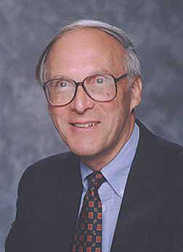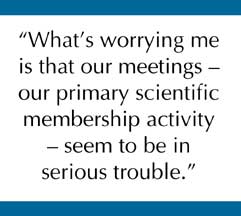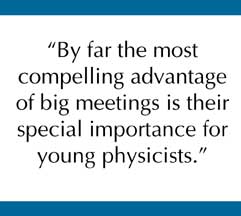APS Meetings Need Reform Now
By James S. Langer
 |
As readers of APS News know, I've been taking every opportunity to stress the growing responsibilities of the American Physical Society. Simply stated, physics no longer sells itself: not to politicians, to future physicists, nor to the public at large. The entire US physics community, APS members and nonmembers alike, depends on the APS to make the case for our field.
The APS has been remarkably effective in this role. Its statements and advice are taken seriously by political leaders and the media. This effectiveness depends primarily on our reputation for wisdom and objectivity, but it also depends on the size and vitality of the community we represent — i.e., our membership. Thus, membership in the APS is critical for maintaining the health of the physics community. I see a major problem emerging here. Our traditional mechanisms for maintaining the size and financial strength of the APS are changing just as dramatically as the political climate. And, unlike some other scientific societies the membership of the APS has not been growing in recent years.
Why do physicists join the APS? In the past, the answer was simple. We joined because we wanted to be part of and to support the larger physics community; and also because membership was essential to our professional careers. We needed ready access to the Physical Review, and we came to the regular APS meetings to exchange ideas and information. Today, however, neither of the latter motives is as compelling as they once seemed.
The APS is by far the world's leading publisher of scholarly physics journals, and publishing remains one of its very most important responsibilities. However, individual subscriptions to the Physical Review no longer make sense for most of us. We count on our home institutions to buy "site licenses" that give us access, via our computers, to a huge database of scientific literature. Thus, access to the APS journals has been disconnected from membership in APS.
 |
That leaves the APS meetings as our single most important membership benefit. There are other benefits, of course: free subscriptions to Physics Today, participation in APS educational and public outreach activities or in human rights advocacy. Our established purpose, however, is to "advance and diffuse the knowledge of physics," and our core competence is as a scientific society. Therefore, our core rationale for membership had better be science, not public affairs. If future generations of physicists join the APS primarily because they agree with our positions on issues of public policy, then we will be known primarily for those positions rather than for our scientific objectivity, and we will become less effective in both science and public outreach.
What's worrying me is that our meetings - our primary scientific membership activity - seem to be in serious trouble.
The major bright spot in this picture is the March Meeting, which focuses on condensed-matter and materials physics and related subjects, and is attended by about 5,000 people every year. There are roughly that number of invited plus contributed talks, presented in about 30 parallel sessions spread over five days. The meeting is organized jointly by a group of APS units whose leaders get together each year in the fall to select invited speakers and symposia. Throughout my career, although my research interests have shifted over the years, the APS March Meeting has remained a fixed point on my professional calendar. I know that a large fraction of the most active people in my areas of interest will be there, and that the speakers will bring me up to date, not just in my current specialty, but in many other areas where relevant ideas may be emerging.
The March Meeting is big, but it may not yet be big enough. I think we need to bring back more industrial physics; FIAP and other units and topical groups are working hard to do so. I'd also like to see more active participation by the Division of Fluid Dynamics and, more generally, more aggressive efforts by many units to include sessions in far-flung interdisciplinary areas of soft condensed-matter physics, biology, complex systems, and the like. If our units continue to work together constructively in these efforts, we'll be in very good shape.
Now for the bad news.
The only other general APS meeting is the one we hold in April. I seldom went to the April Meeting until I joined the presidential line. In the spring of 2000, however, I had official responsibilities at the meeting in Long Beach; and my concern about what I saw there is a major part of my reason for writing this article. The April Meeting has declined to less than one quarter the size of the March Meeting. Most of the APS divisions that participate in organizing it hold their own separate meetings elsewhere and at other times. Few, if any, of my colleagues that I saw last April seemed to use this meeting as a principal professional activity in the way that many of us use the March Meeting. Prominent physicists came to give their invited talks or receive prizes and then left as soon as possible. There were essentially no commercial exhibitors. There were some excellent special symposia; the organizers had made heroic efforts to schedule plenary sessions as well as other invited sessions of general interest. I listened, for example, to accelerator physicists talking about new ideas involving lasers and plasmas, but was keenly aware that there were hardly any laser or plasma physicists present to participate in the discussions. The audiences seemed small compared to what I would have expected for comparable sessions in March.
 |
As bad as it may seem, the possible demise of the April meeting isn't nearly so serious a threat to the APS as the centrifugal forces that are afflicting many of our units. Not only have many APS units been holding separate meetings but, in some cases, the barriers between these units appear to be growing despite clear needs for bringing people together. Last year, for example, the Division of Laser Science (DLS) expressed interest in combining its meeting with the Division of Atomic, Molecular, and Optical Physics (DAMOP); but, so far as I know, nothing has happened. Similarly, the Division of Plasma Physics (DPP) declined a proposal to merge with the April meeting and move the whole event to the fall. Plasma physics, a field of wide-ranging importance, is under stress because of funding crises in its key area of fusion energy. I think it might be enormously important for the DPP to take advantage of the strengths of the APS in broadening its horizons.
For some years, the Division of Computational Physics (DCOMP) has met in conjunction with the March Meeting. I have gone to their sessions quite often, not just out of idle curiosity, but because some talks were directly relevant to my current research and I needed to know what was happening. This year, DCOMP has decided to hold a stand-alone meeting because, I am told, they want to emphasize that computation is just as relevant to particle and astrophysics as it is to condensed matter. That's absolutely true. But why, then, deprive all but the specialists of the chance to attend their sessions?
I fully realize that small, independent unit meetings are a long-standing APS tradition. In many ways, they can be more comfortable than big general meetings, and the organizers have a better sense of being in control of the program and extracurricular activities such as banquets and award ceremonies. But small meetings do not take best advantage of the strengths of the Society as a whole. Larger meetings are much more natural mechanisms for providing interactive, cross-disciplinary opportunities, and it is relatively easy for a large society like the APS to organize them efficiently. In contrast, neither the APS nor its units have any natural advantage - as compared to, say, the Institute for Theoretical Physics in Santa Barbara or the Aspen Center - in organizing innovative special-topics workshops or other small, focused events. I think that our unit meetings will have a much harder time keeping themselves relevant to the rapidly changing natures of their fields if they remain separate instead of combining with other units.
By far the most compelling advantage of big meetings, in my opinion, is their special importance for young physicists. We take great pride in the fact that an education in physics is an excellent preparation for a wide variety of careers. Only a fraction of the graduate students who specialize in experimental high-energy physics, for example, expect to continue in that field for the rest of their lives. In addition to their knowledge of particle phenomenology and their problem-solving abilities, many of these students are skilled in scientific instrumentation and data analysis, and are prepared to use those skills in a wide variety of careers in science or technology. They need exposure to fields beyond their areas of specialization, and they also need opportunities to talk with people who might offer them jobs. That's what happens at the March Meeting, where recently I have been seeing not just large numbers of young people, but also large numbers of employers competing for their services. I think that all our units ought to be providing the same opportunities for young physicists.
There are yet other advantages of large meetings. The March Meeting is big enough to attract substantial numbers of commercial exhibitors, whose presence adds greatly to the professional content of the meeting. The March Meeting is also big enough to provide an effective forum for discussing general issues such as federal science funding, electronic publication, or trends in education. A year ago in Minneapolis, about 2,000 people attended a special session on the proposed federal initiative in nanoscale science and technology. The speakers - all key players in the field - found this a useful forum for engaging a large fraction of the relevant scientific community in the national debate.
I belong to two other scientific societies that are in many ways comparable to the APS: the American Geophysical Union, and the Materials Research Society. Both are growing organizations that are providing important leadership for their fields. Like the APS, both publish research journals. Unlike the APS, however, both use large general meetings as their principal membership activities. The AGU and MRS meetings and memberships are large and growing; ours is not.
In short, the APS has a serious problem. I think that the solution is obvious: we must move toward consolidating our meetings. At the very least, we should move in the directions that we started but aborted last year, shifting the April meeting to the fall and adding other units to it, i.e., DAMOP, DLS, DPP, etc. We also should encourage all of the units that participate in this new general meeting to make it their principal event, including their most urgent special symposia.
It's already too late to make these changes quickly; we have had to book facilities three or more years in advance for all APS meetings and cannot reasonably change those commitments. Given that lead time, however, large-scale changes are feasible. We have a highly professional meetings department, led by Donna Baudrau, that has gained valuable experience in organizing large events such as the Centennial celebration in Atlanta and the increasingly complex March Meeting. With a competent and well-staffed meetings department, we shall find it much easier and more economical to organize unit meetings as components of general meetings rather than as stand-alone events. And, the more our meetings business grows, the better the service we'll be able to provide.
I don't think that we can wait much longer to reform the APS meetings. Like any competitive business whose success depends on building and maintaining customer loyalty, our meetings business is intrinsically unstable. The APS meetings must be visibly the most important and exciting events of their kind, attractive especially to young scientists who are moving into new areas of physics and related fields. The alternative is that we shall lose some of these meetings, perhaps quickly and suddenly, and then the very future of our Society will be in jeopardy. We cannot continue to be influential in public affairs, or even to remain a major, non-profit, publisher of scientific journals, unless we maintain our unique identity as a broadly representative, membership-based scientific organization.
James S. Langer was President of APS in 2000.
©1995 - 2024, AMERICAN PHYSICAL SOCIETY
APS encourages the redistribution of the materials included in this newspaper provided that attribution to the source is noted and the materials are not truncated or changed.
Associate Editor: Jennifer Ouellette
May 2001 (Volume 10, Number 5)
Articles in this Issue

